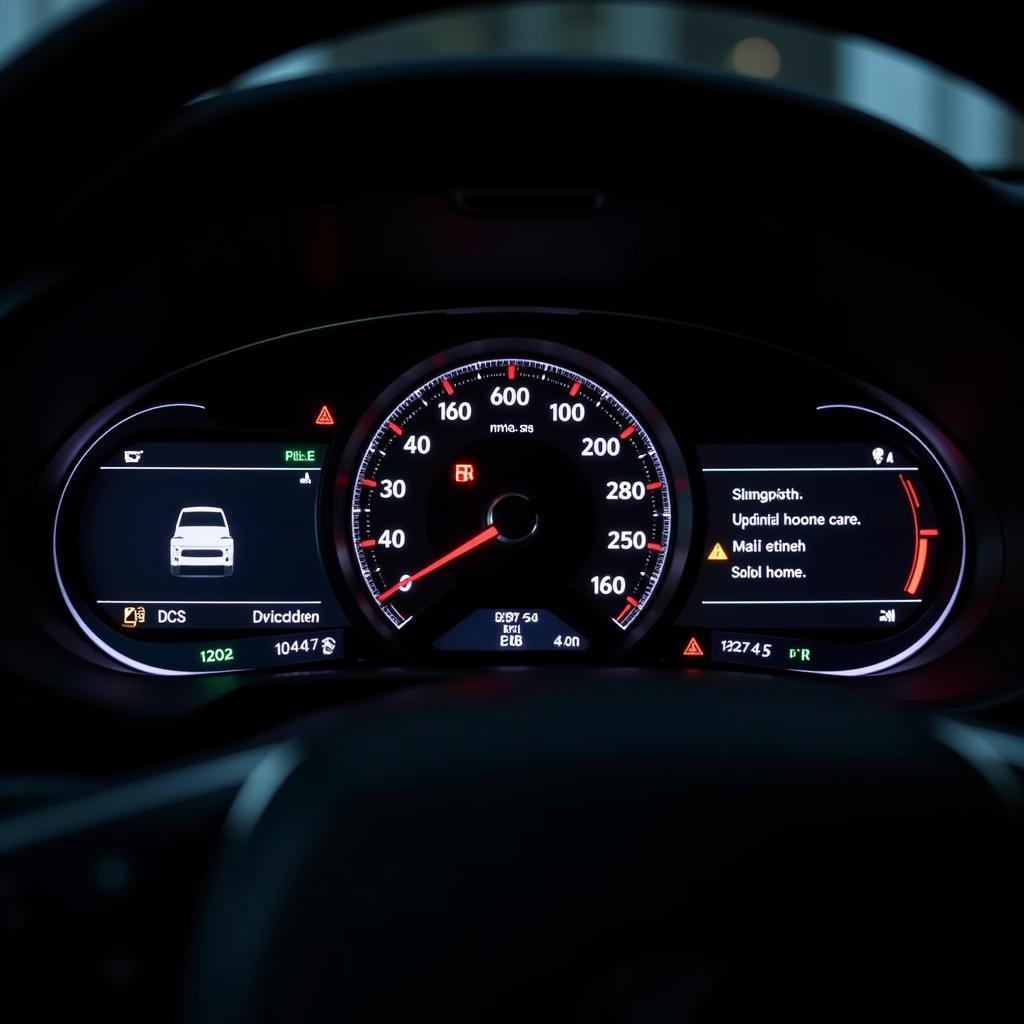In today’s technologically advanced world, our vehicles are becoming increasingly sophisticated. With this sophistication comes the need for advanced diagnostics, often referred to as “in-car diagnostics.” This intricate system acts as your car’s central nervous system, constantly monitoring its health and performance.
 Modern Car Diagnostics Dashboard
Modern Car Diagnostics Dashboard
What are In-Car Diagnostics?
In-car diagnostics refer to the self-diagnostic and reporting capabilities of modern vehicles. This system comprises a network of sensors and electronic control units (ECUs) that continuously monitor various aspects of your car’s operation. These systems collect and analyze data from different components, such as the engine, transmission, brakes, emissions system, and more.
When a potential issue arises, the system triggers a warning light on your dashboard and stores a corresponding Diagnostic Trouble Code (DTC) in its memory. These codes, often cryptic combinations of letters and numbers, provide valuable insights into the nature of the problem.
The Importance of In-Car Diagnostics
In-car diagnostics have revolutionized vehicle maintenance and repair in several significant ways:
- Early Problem Detection: By identifying issues in their early stages, in-car diagnostics allow for timely intervention, preventing minor problems from escalating into major (and often costly) repairs.
- Accurate Diagnosis: Gone are the days of relying solely on mechanics’ intuition. In-car diagnostics provide accurate and objective data, reducing the guesswork involved in identifying the root cause of a problem.
- Improved Repair Efficiency: With precise diagnostic information, mechanics can quickly pinpoint the faulty component, reducing repair time and labor costs.
- Enhanced Safety: By monitoring critical safety systems like airbags, anti-lock brakes (ABS), and electronic stability control (ESC), in-car diagnostics play a vital role in ensuring passenger safety.
Understanding Diagnostic Trouble Codes (DTCs)
DTCs are the language of your car’s diagnostic system. Each code represents a specific problem or malfunction detected by the system. While the codes themselves might seem like a foreign language, understanding their basic structure can be helpful:
- The First Character: This letter indicates the system where the fault lies. For instance, “P” refers to the powertrain, “B” to the body, “C” to the chassis, and “U” to network and communication systems.
- The Second Character: This number provides information about the code’s origin. “0” typically indicates a standardized code defined by the Society of Automotive Engineers (SAE), while “1” usually signifies a manufacturer-specific code.
- The Remaining Characters: These numbers and letters pinpoint the specific area or component within the system that’s experiencing the issue.
How are In-Car Diagnostics Performed?
Accessing and interpreting the information provided by your car’s diagnostic system typically requires a specialized tool known as an OBD-II scanner. OBD-II, short for On-Board Diagnostics, is a standardized system present in most vehicles manufactured after 1996.
OBD-II scanners, available in various forms, from handheld devices to smartphone apps, can retrieve DTCs, clear codes, and provide real-time data from various sensors.
Common In-Car Diagnostic Tests
While the specific tests performed can vary depending on the vehicle and the suspected issue, some common in-car diagnostic procedures include:
- Engine Analysis: This involves checking for misfires, fuel system issues, and emission control problems.
- Transmission Diagnostics: This assesses the health of the transmission, including shifting performance, clutch operation, and fluid levels.
- Brake System Inspection: This covers the inspection of ABS components, brake fluid levels, and brake pad wear.
- Airbag System Check: This ensures the proper functioning of airbags, seatbelt pretensioners, and other safety restraint systems.
The Future of In-Car Diagnostics
As technology continues to evolve, in-car diagnostics are becoming increasingly sophisticated. We can expect to see:
- Predictive Diagnostics: Using artificial intelligence and machine learning, future systems will be able to predict potential problems before they even occur, allowing for proactive maintenance.
- Remote Diagnostics: Mechanics will be able to remotely access vehicle data, allowing for remote diagnosis and even software updates.
- Increased Integration: In-car diagnostics will become seamlessly integrated with other vehicle systems, such as infotainment and navigation, providing drivers with real-time information about their vehicle’s health and performance.
Conclusion
In-car diagnostics have become an essential aspect of modern vehicle ownership, offering numerous benefits for car owners and mechanics alike. Understanding the basics of these systems can empower you to take a more proactive role in maintaining your vehicle’s health, ensuring optimal performance and longevity. When faced with warning lights or unusual vehicle behavior, don’t hesitate to seek the expertise of a qualified mechanic who can utilize in-car diagnostics to diagnose and address the issue effectively.
FAQs about In-Car Diagnostics
- Can I perform in-car diagnostics myself? While basic OBD-II scanners are readily available, interpreting the data and diagnosing complex issues often requires specialized knowledge and experience.
- How often should I get my car’s diagnostics checked? It’s generally recommended to have your car’s diagnostics checked at least once a year or as part of your regular maintenance schedule.
- What should I do if a warning light appears on my dashboard? It’s crucial not to ignore dashboard warning lights. Consult your owner’s manual and consider taking your car to a qualified mechanic for a proper diagnosis.
For more information on car diagnostics, check out our articles on multiple error code car diagnostics, car diagnostics toolkit and eclipse car diagnostics.
Still have questions? Contact our 24/7 support team via WhatsApp: +1(641)206-8880, or Email: [email protected]. We’re here to help you navigate the world of car diagnostics.

Leave a Reply